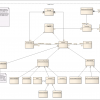 |
Requirements Mapping Using Business Function Test Suites On this team, testers were overcommitted, avoidable defects were surfacing, and documentation was hard to find. Worse, trust and morale were low. Upgrading tools was out of the question, so the testers decided to take matters into their own hands and create incremental change themselves. Here's how a team added a new type of traceability to its requirement test case world.
|
|
 |
Fitting Technical Writing into Agile Development As teams strive to move to a mature agile process, technical writers must adapt as effectively as the development personnel. This new agile process demands that knowledge dealing with software or product releases is only sparingly documented up front, making the technical writer's job of gathering information much more dependent on talking with people over reading requirements.
|
|
 |
Slim Down Your Test Plan Documentation Test plans are essential for communicating intent and requirements for testing efforts, but excessive documentation creates confusion—or just goes unread. Try the 5W2H method. The name comes from the seven questions you ask: why, what, where, when, who, how, and how much. That's all you need to provide valuable feedback and develop a sufficient plan of action.
|
|
 |
Streamline Your Agile Requirements by Avoiding Bloated Backlogs In agile development, a bloated backlog results from teams accumulating huge lists of requirements, usually in the form of user stories. Retaining every possible story for building the product weighs down the backlog while squeezing (or obscuring) the highest-value stories. The best way to help minimize this risk is to optimize the time spent defining and refining the product priorities.
|
|
 |
Simplify Your User Stories: Make Them Independent Writing independent user stories seems simple, but it is actually difficult to do well. There are often parts of some stories that are dependent on other stories' functionalities, so it's not easy to keep them separated. Kris Hatcher relates how his team wrote and scored stories to keep them independent but still meeting acceptance criteria.
|
|
 |
Estimating Business Value in the Shark Tank You can use analytical methods to assign business value to a user story, of course, but another way is simple estimation. Allan Kelly describes an estimation exercise that combines the Scrum tool of planning poker with a TV show format to add some fun. You end up with enlightening conversation and revealed requirements.
|
|
 |
Business and Development: Working Together to Build Better Products Business stakeholders and DevOps teams both have to take an active approach to app development, but neither faction should have to change practices and processes in order to get their needs across. Investing the time to establish communication between these teams will drive delivery of the applications customers demand.
|
|
 |
Working with Nonfunctional Requirements Nonfunctional requirements describe aspects of the system that do not map onto a single piece of functionality. Essentially, they're constraints you need to operate within. Allan Kelly details how running performance tests regularly can be the key to nonfunctional requirements, as well as how much value these constraints produce.
|
|
 |
Acceptance Criteria, Specifications, and Tests One of the benefits of agile is how it helps specify requirements. Instead of trying to predict the future with your requests, you can wait an iteration and see if more criteria are needed. This article gets into how executable specifications, specification by example, and test automation can help further improve your requirements management.
|
|
 |
Defining Acceptance Criteria for Agile Requirements Acceptance criteria can be helpful in expanding on user stories in order to capture requirements for agile projects. However, acceptance criteria should not be a route back to long, detailed documents, and they are not a substitute for a conversation. This article tells you how and when acceptance criteria should be written and employed.
|
|

